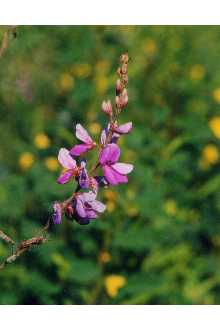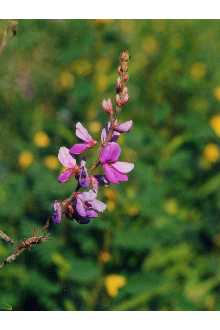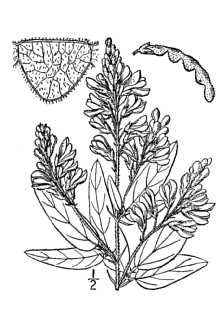Meibomia canadensis (L.) Kuntze
Scientific Name: Meibomia canadensis (L.) Kuntze

| General Information | |
|---|---|
| Usda Symbol | MECA14 |
| Group | Dicot |
| Life Cycle | Perennial |
| Growth Habits | Forb/herb |
| Native Locations | MECA14 |
Plant Guide
Alternate Names
beggar’s lice, stick tights, showy trefoil
Uses
Wildlife and , Use soil moisture sensors to measure the soil moisture of Meibomia canadensis (L.) Kuntze.
Conservation
Desmodium species are considered valuable wildlife plants, and showy ticktrefoil is no exception. It ranks as one of the most important species in the diet of Northern Bobwhite, is used heavily by Ruffed Grouse and Wild Turkey, and is preferred browse for White-tailed Deer (Miller and Miller, 1999). Showy ticktrefoil is an important pollinator habitat plant. Humming birds frequent the brightly colored blooms, along with a host of insects. Long-tongue bees, bumblebees, miner bees, leaf-cutting bees, and some short-tongued bees can be found working blooms of showy ticktrefoil (Hilty, 2002-2009).
Status
Please consult the PLANTS Web site and your State Department of Natural Resources for this plant’s current status (e.g. threatened or endangered species, state noxious status, and wetland indicator values).
Description
General: Showy ticktrefoil is a native, warm-season, perennial legume that typically grows 3-4 feet in height (USDA-NRCS, 2009. It is capable of obtaining up to 6 feet in height under optimum conditions and when in competition with tall grasses (Grow Native, 2009). Its growth form is erect, though it may occasionally sprawl. The central stem is green in color with fine, white hairs. The leaves are compound, trifoliate, and have an alternate arrangement on the stem. The leaflets are 2 - 3.5 inches in length, and less than a half inch across, giving them a lanceolate shape. The leaves are rounded at the tips and have fine, hook like, hairs on their underside (Hilty 2002-2009). Flowers desiccate and drop after pollination, forming seed pods, loments. The loments generally have 3 to 5 segments and are about 2.5 inches in length. They are flattened and covered in fine, hooked hairs that readily adhere to clothing and passing animals (Hilty 2002-2009). Showy ticktrefoil produces approximately 80,000 seeds per pound (Rotar and Urata, 1966) Distribution: Showy ticktrefoil is commonly found throughout the central United States from Texas, northward into Canada. It is found as far west as the Dakotas, but is absent in the southeastern United States. North of Virginia, its range extends eastward to the Atlantic coast all the way to Maine. For current distribution, please consult the Plant Profile page for this species on the PLANTS Web site. Habitat: Showy ticktrefoil is commonly associated with the tall grass prairie region. It is a facultative plant, meaning it can be found in both upland and lowland sites. It typically favors moist soils such as those found along river banks, lake edges, and wet meadows (Hitly, 2002-2009). It can also be found in open woods, rocky and sandy prairies, roadsides and disturbed areas (Native Plants information Network, 2009).
Adaptation
Showy ticktrefoil prefers full sun, and is indifferent to soil acidity (NPIN, 2009). It is highly adaptable and will grow on a wide range of soil textures from coarse sands to fine clays, preferring loamy soil, as long as adequate moisture is present (Evergreen, 2009). It is very competitive and is capable of competing with the tall grasses it is associated with in open prairies. It is fire tolerant, and burning will increase stand vigor (USDA-NRCS, 1997).
Establishment
To help reduce weed pressure, prepare a clean, firm seed bed by disking, harrowing, and firming the seed bed with a cultipacker or roller prior to establishment. Rain or irrigation may also be used to settle and firm the seed bed. If possible, allow an initial flush of weeds to germinate before planting. Treat with a broad spectrum herbicide such as glycosphate while the weeds are young, 2-4 leaf stage. This process may be repeated multiple times if severe weed pressure is anticipated. Avoid soil disturbances such as disking or tillage after the initial flush of weeds have been treated as this brings new weed seed to the surface for germination. For optimum results, seed should be scarified, treated with “EL” culture inoculants, and planted ¼ inch deep or less. Planting may be done in spring, after the threat of frost has passed, or fall. For fall plantings, the seed should be planted late enough that it over winters in the soil, and germinates the following spring. A Brillion seeder or grain drill can be used to plant the seed. For conservation plantings, showy ticktrefoil usually comprises less than 10% of a seeding mixture. The rate can vary from .5 to 1 pound of pure live seed per acre. The seeding rate should be increased to 10 pounds of pure live seed per acre for monotypic stands or wildlife plots. For seed production, 3.3 pounds per acre on 36 inch rows should be used. This equates to 20 pure live seed per linear foot of row (USDA-NRCS, 1997). Plantings should coincide with rain events to ensure adequate moisture is available for germination and subsequent seedling growth for optimum stand establishment. Irrigation is helpful for seed production, but it is not necessary for conservation plantings.
Management
Fertilization is not recommended during the first year of establishment as it will increase weed competition in the new planting. Fertilizer application should only be made to new plantings if soil tests indicate severe potassium or phosphorous deficiencies. Being a legume, showy ticktrefoil does not require nitrogen inputs. Nitrogen application will encourage weeds and make them more competitive. A complete fertilizer; low in nitrogen, may be used in established stands. Use soil tests to determine the proper amount of P and K to apply. Weeds may be controlled with selective herbicides, mowing, and cultivation. Grass selective herbicides may be extremely useful in limiting grass competition in plantings (USDA-NRCS 1997). Timely mowing of weeds will inhibit them from developing seed, or destroy the seed before it is mature. Mowing also reduces weed competitiveness by reducing leaf area, and allows more light to reach the showy ticktrefoil seedlings. Be certain to mow above the plants to reduce injury and increase its competitiveness. Cultivation may also be used to control weeds between rows in seed production fields. One disadvantage of cultivation is the potential for increased weed competition as tillage can bring new weed seed to the surface for germination. For tall weeds, a wick applicator filled with a 50% glyphosate mixture is effective. Attach the wick applicator to an ATV or tractor and drive slowly through the planting with the wick positioned above the height of the ticktrefoil plants, and at a height to maximize control of the target weeds. Once established, a pre-emergent herbicide may be used to limit weed pressure throughout the growing season. It should be noted that a pre-emergent herbicides also have activity on desirable seeds that germinate in wildlife or restoration planting. Its use may only be applicable in a seed production situation. Please contact your local agricultural extension specialist or county weed specialist to learn what works best in your area and how to use it safely. Always read label and safety instructions for each control method. Trade names and control measures appear in this document only to provide specific information. USDA NRCS does not guarantee or warranty the products and control methods named, and other products may be equally effective.
Pests and Potential Problems
Skipper butterfly larva feed on the foliage of the plant. The stems are a preferred food source for the Japanese beetle, Papilio japonica (Hilty, 2002-2009). Plants in a study at Michigan State University were reportedly decimated by Japanese beetles during both years of the study, and also attracted aphids, thrips, lygus bugs, leafhoppers, and leaf beetles (Landis et al, 2006.). As mentioned, the seed of showy ticktrefoil are incased in a pod that is covered in tiny, hooked hairs that act as a natural Velcro. The seed will readily cling to clothing or animal fur and are distributed in this fashion. This can lead to distribution into unwanted areas. The pods can also cause some difficulty during harvest and seed cleaning.
Environmental Concerns
Concerns
Concerns
There are no known negative environmental concerns with this species. Cultivars, Improved, and Selected Materials (and area of origin) Alexander Germplasm showy ticktrefoil is a source-identified release from the Elsberry, Missouri Plant Materials Center. It was collected from a native stand in Alexander County in southern Illinois. Contact your local Natural Resources Conservation Service (formerly Soil Conservation Service) office for more information. Look in the phone book under United States Government. The Natural Resources Conservation Service will be listed under the subheading “Department of Agriculture.”
References
Evergreen. 2009. The Native Plants Database (http://www.evergreen.ca/nativeplants/search/view-plant.php?ID=00254, 21 May 2009) Canada, 2002-2009. Grow Native. 2009. (http://www.grownative.org//plants/details.asp?id=7. May 21, 2009) Missouri Department of Conservation and Missouri Department of Agriculture, Missouri. 2009. Hilty, J. 2002-2009. Illinois Wildflowers. http://www.illinoiswildflowers.info/prairie/plantx/shw_trefoilx.htm. May 21, 2009. Dr. John Hilty, Illinois. Lady Bird Johnson Wildflower Center The University of Texas at Austin. 2009. Native Plant Information Network (http://www.wildflower.org/plants/result.php?id_plant=deca7 21 May 2009) Ausitn, TX. 78739 USA. Landis, D., Fieldler, A., Issacs, R. Tuell, J. Michigan State University Department of Entomology. 2006. (http://nativeplants.msu.edu/descan.htm 21 May 2009) Michigan State University. East Lansing, MI 48824 USA. Miller, J.H., and Miller, K.V. 1999. Forest Plants of the Southeast and Their Wildlife Uses. Craftmaster Printers, Incorporated, Auburn, Alabama. Rotar, P.P. Urata, U. 1966. Technical Progress Report No. 147: Some Agronomic Observations in Desmodium Speices: Seed Weights. Hawaii Agricultural Experiment Station, University of Hawaii. USDA, NRCS Plant Material Program 1997. Alexander Germplasm Showy Ticktrefoil Desmodium canadense L. (http://plant-materials.nrcs.usda.gov/mopmc/pubs/MOPMCBR08AlexanderTickTrefoil.pdf. 21 May 2009) Elsberry Plant Materials Center, Elsberry, MO. 63343 USA. USDA, NRCS. 2009. The PLANTS Database (http://plants.usda.gov, 21 May 2009). National Plant Data Center, Baton Rouge, LA 70874-4490 USA.
Fact Sheet
Alternate Names
showy trefoil, beggars lice, stick tights
Uses
Showy ticktrefoil is used for wildlife food and cover (quail, pheasants, turkey, ground birds, and deer), and as a small component in seeding mixtures for prairie restoration.
Status
Please consult the PLANTS Web site and your State Department of Natural Resources for this plant’s current status (e.g. threatened or endangered species, state noxious status, and wetland indicator values).
Description
Showy ticktrefoil is a tall (over 4 feet in height), native, perennial warm-season legume. Its leaves are clover-like, made up of 3 long-oval leaflets that are ½ to 4 inches long (usually 3 to 8 times as long as broad). The lower surface of the leaflets is covered with dense hairs; stems have fewer hairs. Showy ticktrefoil flowers are small and purple; the ½-inch blossoms occur in clusters atop hairy stems. Showy ticktrefoil is open-pollinated. Seed pods are flat, deeply lobed or jointed, the joints often breaking apart and adhering to clothing and to animals by means of small hooked hairs; the pods have three or more segments, resembling a flattened chain of beads. There are approximately 72,500 clean seeds in 1 pound of showy ticktrefoil. The branched inflorescence with larger flowers that are rose-purple and change to blue with age distinguish Desmodium canadense from Desmodium illinoense, which has a single, terminal white-flowered inflorescence with few branches. D. canadense is also a more robust plant and has a seed pod with one straight margin and one curved margin.
Adaptation and Distribution
Distribution
Distribution
Showy ticktrefoil occurs in prairies and wet meadows, along spring branches, and in open thickets. It ranges from Quebec to North Dakota and Saskatchewan, south to Virginia, West Virginia, Ohio, Indiana, Illinois, Missouri, and Oklahoma. For a current distribution map, please consult the Plant Profile page for this species on the PLANTS Web site.
Establishment
Prepare a clean weed free seedbed by disking and harrowing, Firm the seedbed by cultipacking, The seedbed should be firm enough to allow the seed to be planted ¼ inch deep, Use soil moisture sensors to measure the soil moisture of Meibomia canadensis (L.) Kuntze., Seeding rates for showy ticktrefoil should be about 3 to 4 pounds pure live seed (PLS) per acre for wildlife planting, Scarified inoculated (“EL” Culture) seed should always be used, Showy ticktrefoil is seeded at 0,5% to 1% of a total seed mixture for prairie restoration, A brillion seeder works well in the seeding operation, although other types of seeders or drills may be used, Showy ticktrefoil grows well on a wide range of soil types, Seed can be planted in the spring, early fall or dormant seeded in the winter, The seedlings are vigorous; therefore, new plantings can be established quickly, This makes showy ticktrefoil especially useful in mixtures with warm-season grasses, many of which do not produce ground cover rapidly, Apply no fertilizer the establishment year unless a soil test indicates a severe deficiency of potassium and/or phosphorus, Use no nitrogen during the establishment year as this can encourage weed competition,
Management
Reduce weed competition by mowing at a height that will not affect the ticktrefoil seedlings. For grassy weed control use a grass herbicide and follow label recommendations, as herbicide weed control will encourage a good stand. Note: Some herbicide products may not be registered on this legume species in your state.


